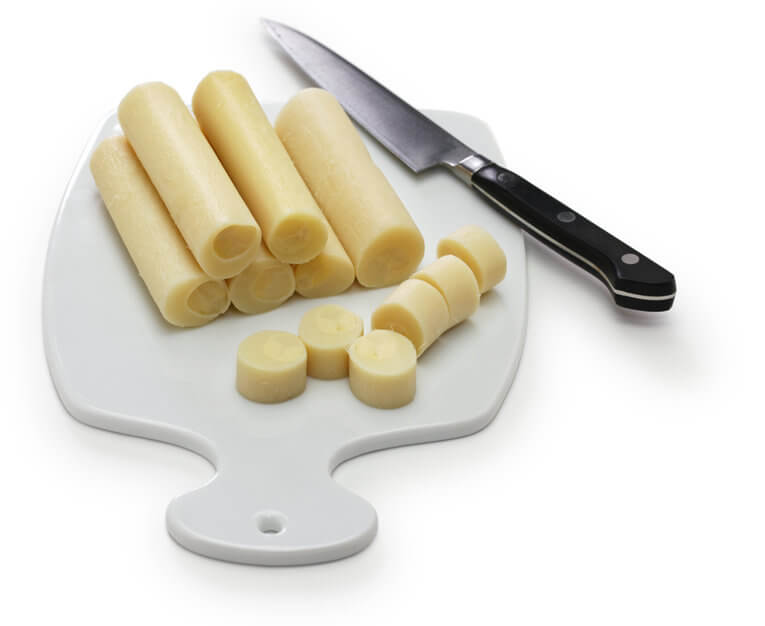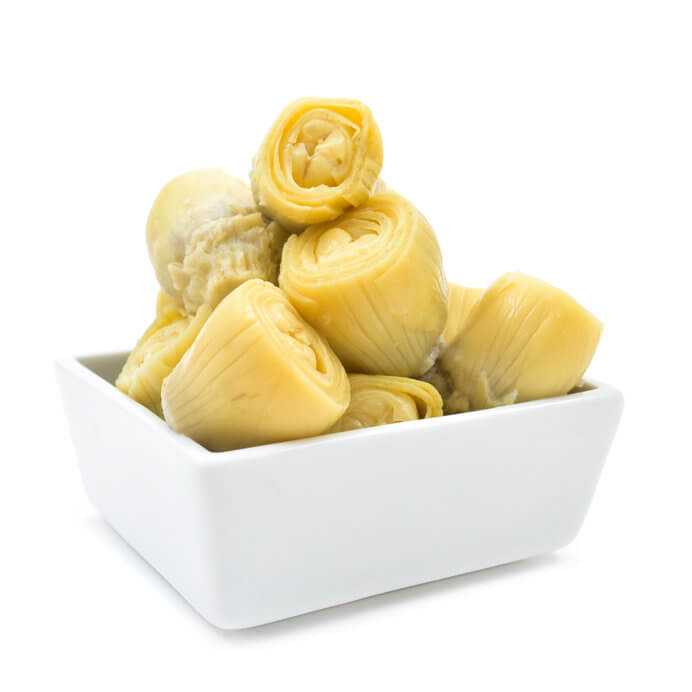In previous articles we’ve gone over the benefits of both hearts of palm as well as artichoke hearts. How do the two compare when stacked up against each other, though? Is one more advantageous than the other? As it turns out, yes, and in this article we’ll be pitting hearts of palm vs artichoke hearts so you can compare and decide for yourself.
In short, the difference between hearts of palm vs artichoke hearts is that palm hearts have fewer calories, fewer carbohydrates, nearly double the fiber, triple the iron contents, and more vitamin C. Artichoke hearts, on the other hand, contain vitamin A.
Let’s delve further into the details.
What Are Hearts Of Palm?
Hearts of palm (sometimes referred to as “palm hearts”) are the edible core of palm trees. Coconut trees are used in most instances, but they can be sourced from other palm varieties as well.

Palm hearts are often canned or jarred and sold in the international aisles of grocery stores. They can be eaten in their whole food form, but it can be rather difficult to locate them.
As far as taste goes, hearts of palm are tender (especially the canned/jarred variety) and have a mild, earthy flavor.
Palm hearts are commonly used as a topping for salads, but they can also be eaten on their own as a nutritious snack or side dish.
What Are Artichoke Hearts?
Artichoke hearts refers to the fleshy core at the center of the artichoke plant. The edible “heart” of the plant is revealed when the leaves are stripped away.

One commonality between hearts of palm vs artichoke hearts is that, much like their palm-based counterpart, artichoke hearts are also commonly packaged in cans and jars for consumption.
Artichoke hearts, however, can also be commonly found in their whole plant form in the produce section of your local grocery store. They may require some additional prep time, but the advantage is that you can avoid the added sodium associated with the canning/jarring process.
Much like palm hearts, artichoke hearts too are commonly used as a salad topping. They also work great in various Italian dishes.
Hearts Of Palm VS Artichoke Hearts
Let’s have a look at how these two hearty plant foods stack up against each other nutritionally.
The following table compares the nutrition facts of an equal serving size of canned hearts of palm vs artichoke hearts:
| Item | Hearts Of Palm | Artichoke Hearts |
| Serving Size | 100g | 100g |
| Calories | 28 | 38 |
| Total Carbohydrates | 4.6g | 7.5g |
| Total Sugar | 0g | 1.3g |
| Dietary Fiber | 2.4g | 1.3g |
| Total Fat | 0.6g | 0g |
| Protein | 2.5g | 2.5g |
| Sodium | 426mg | 300mg |
| Vitamin A | 0mg | 125mg |
| Vitamin C | 7.9mg | 5mg |
| Iron | 3.1mg | 1mg |
As you can see, they actually have more commonalities than differences. Both are relatively low in calories, low in fat, and have a modest amount of vitamin C. They do, however, have quite a bit of sodium, which is mostly due to the canning/jarring process. This can be avoided by opting for the fresh variety.
There are some major differences, however. Let’s have a look.
Hearts Of Palm Have Slightly Less Calories
Calories are important because they’re the unit of measurement used to gauge the energy we consume and expend. Excess caloric intake is associated with weight gain, whereas lower caloric intake is associated with weight loss.
This suggests that monitoring calorie intake can be useful for maintaining a health weight.
Right off the bat we can see that hearts of palm have roughly 30% less calories than artichoke hearts.
This isn’t too significant as the difference between a 100g serving of each is roughly only 10 calories. That may not be much, but when scaled up to larger quantities it could be more impactful.
Palm Hearts Also Have Less Carbohydrates
Another advantage you’ll enjoy when opting for hearts of palm vs artichoke hearts is that they have less carbohydrates too.
This can be particularly advantageous for anyone trying to adhere to a ketogenic diet — a way of eating characterized by keeping carb intake to a minimum so that the body produces “ketones” to use for energy instead.
Much like the difference in calories, the differences in carbohydrates between the two types of hearts is modest, but enough to be significant if consumed in larger quantities.
Nearly Double The Fiber
Not only do palm hearts have less carbs than artichokes hearts, but they somehow contain more fiber as well — nearly double, in fact.
An indigestible form of carbohydrate, fiber is responsible for removing waste from the body.
According to Mayo Clinic, boosting fiber intake can:
- Normalize bowel movements
- Lower cholesterol
- Control blood sugar
- and more
A 100g serving of palm hearts packs 2.4g of fiber, whereas artichoke hearts contain 1.3g.
Triple The Iron
If iron content is of concern to you then the choice between hearts of palm vs artichoke hearts is rather clear as the former packs 3.1mg of iron per 100g serving — or 17% of the Daily Value.
Artichoke hearts, on the other hand, contain 1mg for a similar serving size.
Iron is an essential mineral tasked with producing red blood cells that transport oxygen throughout the body. Insufficient iron intake can lead to a host of health complications such as anemia, according to Mayo Clinic.
Vitamin C
Vitamin C is a water-soluble vitamin with a host of benefits. It acts as an antioxidant, helps the body absorb iron, and boosts immunity, among other things.
If boosting vitamin C intake is of priority to you then hearts of palm are the way to go as they contain 7.9mg — or 13% of the Daily Value — per 100g serving, compared with the 5mg found in a similar serving size of their artichoke counterpart.
Artichoke Hearts Contain Vitamin A
Up until now we’ve gone over all of the advantages that heart palms have over artichoke hearts. However, there is one particular area where the artichoke variety shines brightest, and that would be vitamin A content.
Vitamin A is important for vision, immunity, and cell growth.
While hearts of palm don’t contain any vitamin A, artichoke hearts boast a decent amount with 125mg per 100g serving.
The Bottom Line
To conclude our comparison of hearts of palm vs artichoke hearts, it’s rather clear to see that the advantages weigh heavily in favor of the former. However, that’s not to say that artichoke don’t have their advantages too.
Regardless of whichever you choose, you’re sure to enjoy the tasty texture and nutritional benefits of these two heart varieties.

